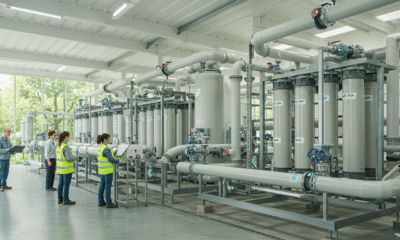

Features
EHS Management is Making the Construction Industry Greener
A growing number of businesses are trying to embrace eco-friendlier practices. One survey found that 78% of consumers say that sustainability is important to them. Another poll found that 77% of businesses say that sustainability has increased customer loyalty.
The construction industry is among those becoming more sustainable. One of the ways that construction companies are embracing sustainability is through EHS policies.
EHS Policies Are Helping Construction Companies Become More Sustainable
The construction industry, known for its complex projects and challenging work environments, faces an array of risks ranging from workplace accidents to environmental hazards. This is where Environment, Health, and Safety (EHS) management becomes crucial. EHS is a discipline and specialty that studies and implements practical aspects of protecting the environment and maintaining health and safety at work. Here’s why prioritizing EHS in construction isn’t just a regulatory requirement but also a critical driver of success and sustainability.
The High Stakes of Safety in Construction
Construction consistently ranks among the most hazardous industries worldwide. Known for its perilous work environments, the sector records numerous accidents and fatalities each year, often far exceeding those in other industries. This high incidence is rooted in the inherent risks associated with construction work—heights, heavy machinery, electrical hazards, and more. As a high-risk business, the industry is keenly aware that the human and financial implications of not prioritizing safety are substantial.
The Human Cost
The human cost of construction accidents is profound. According to U.S. Bureau of Labor Statistics, in 2022 a worker died every 96 minutes from a work-related injury. The leading causes of death on construction sites are known as the “Fatal Four” and consist of:
- Falls from heights
- Being Struck by objects
- Electrocutions
- Caught-in/between accidents
Every year, families lose loved ones, and workers endure injuries that can have permanent consequences, ranging from chronic pain to loss of livelihood.
Economic Implications
Beyond the tragic loss of life and personal trauma, construction accidents carry significant economic implications. The direct costs of accidents—including medical expenses, legal fees, and compensation—can be staggering. Indirect costs such as lost productivity, increased insurance premiums, and damage to the company’s reputation also weigh heavily on a firm’s finances.
Investing in Safety
Investing in comprehensive safety measures is the most effective strategy a construction company can adopt to reduce the risk of accidents. Prioritizing safety includes:
- Training: Regular, high-quality safety training keeps best practices top of mind for workers and management.
- Personal Protective Equipment (PPE): Providing state-of-the-art PPE and ensuring its proper use can prevent numerous injuries.
- Safety Technology: From wearables that track a worker’s location and vitals, to systems that alert operators of nearby workers, technology offers revolutionary ways to enhance safety.
- Mental Health Resources: Addressing mental health on construction sites can prevent accidents stemming from inattention or operating under impairment.
- Enforcement and Monitoring: Strict enforcement of safety protocols and real-time monitoring help identify and mitigate risks promptly.
Failure to maintain proper safety equipment or adhere to building codes can sometimes result in major catastrophic damages, including loss of life. In these cases, the survivors may have grounds for a wrongful death claim.
Protects the Workforce
Arguably, one of the most compelling reasons for an emphasis on EHS is the protection it offers to workers. The construction sector often deals with hazardous conditions that can lead to serious injuries or fatalities. Reliable EHS practices ensure that workplace health and safety risks are identified, controlled, and monitored regularly, thereby minimizing the potential for accidents and occupational illnesses.
Preserves the Environment
Construction activities can have a significant impact on the environment, from disturbing ecosystems to creating waste and pollution. Implementing solid environmental management within an EHS framework can mitigate these effects. It ensures that construction projects comply with environmental regulations and minimize their carbon footprint. By doing so, companies can avoid substantial fines and preserve the local ecology, presenting themselves as responsible corporate citizens. Minimizing the negative environmental impacts of business is important.
Ensures Compliance
Construction companies must adhere to a complex web of laws and regulations that govern their operations. EHS programs help businesses stay in compliance with these regulations, reducing the risk of legal penalties, work stoppages, and reputational damage. Compliance with EHS standards also goes hand in hand with quality assurance, often resulting in higher-quality project outcomes.
Boosts Worker Morale and Retention
Knowing that their employer values their health and safety can significantly boost worker morale. Workers are likely to be more engaged and loyal to a company that invests in their well-being. A robust EHS program can also attract talent, as prospective employees look for workplaces with excellent safety records and established health and environmental policies.
Enhances Productivity
A well-implemented EHS program minimizes the risk of accidents on-site, reducing downtime and ensuring that projects run smoothly and on schedule. Efficient EHS strategies can also streamline processes, reduce waste, and prevent equipment downtime, all of which contribute to improved productivity.
Promotes Sustainability
Integrating EHS in construction projects promotes sustainability by encouraging the use of materials and practices that have a lesser environmental impact. This not only aids in the conservation of resources but also aligns with the growing global focus on sustainable development, potentially opening new market opportunities for eco-conscious construction firms.
Reduces Costs
Investing in EHS can lead to significant financial savings in the long run. Effective safety measures can reduce accidents, which in turn lowers medical costs, insurance premiums, and potential litigation expenses. Environmentally sound practices can also economize resource use and waste management, translating to cost efficiencies.






























